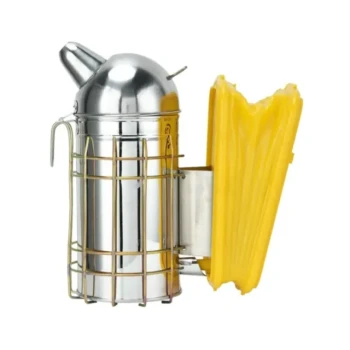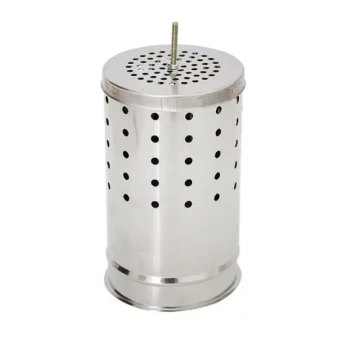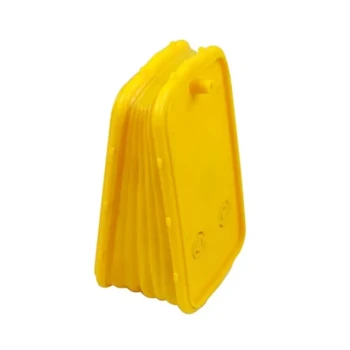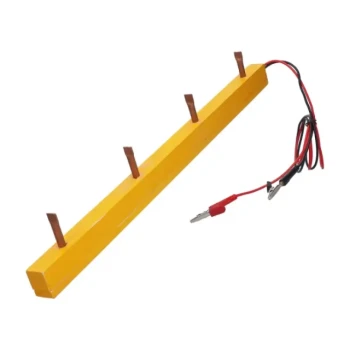The most suitable fuels for a bee smoker are natural, untreated, and dry materials that burn slowly to produce a cool, white smoke. Excellent choices include dried pine needles, untreated cotton scraps, wood shavings, and sisal baling twine. The core principle is to select a fuel that smolders consistently without producing excessive heat or releasing any toxins harmful to the bees.
Choosing the right smoker fuel is not just about finding something that burns. The true goal is to create a calm, cool, and dense smoke that pacifies the bees without harming them, ensuring both their safety and yours.
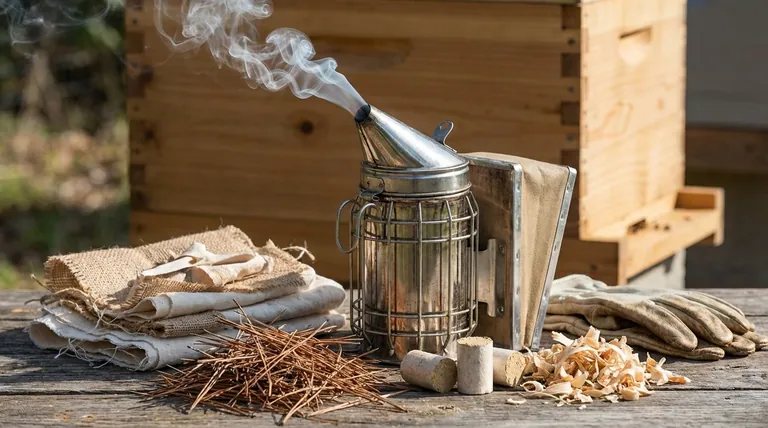
The Guiding Principles of a Good Smoker Fuel
To select the best fuel, it's essential to understand the "why" behind the recommendations. The ideal fuel must meet three critical criteria that directly impact hive health and the effectiveness of your inspections.
Principle 1: Non-Toxic to Bees (and You)
The smoke comes into direct contact with the bees, their hive, and potentially their honey. Therefore, the fuel must be completely free of chemicals, pesticides, glues, or natural toxins.
Any material that has been chemically treated, painted, or pressure-treated is unacceptable. This also includes avoiding naturally toxic plants like poison ivy, which can be harmful to both you and the bees.
Principle 2: Slow Smolder, Not a Hot Fire
A bee smoker is designed to smolder, not to burn like a campfire. The goal is to generate smoke, not high heat.
Fuels that burn too quickly or too hot, like very fine sawdust or dry leaves, will create a hot, thin smoke that can injure or agitate the bees. The best fuels are dense enough to smolder for a long time with minimal maintenance.
Principle 3: Cool, White Smoke Production
The quality of the smoke is your most important indicator. You are aiming for a thick, cool, white smoke.
If you see dark or black smoke, it is a sign that your fuel is burning too hot or that you are running low. This hot smoke is ineffective and harmful, and you should immediately add more fuel to cool it down.
Recommended Fuel Categories
You can find excellent smoker fuel from natural, repurposed, or commercial sources. Many beekeepers use a combination depending on availability.
Natural and Foraged Materials
These are often the most cost-effective and readily available options.
- Pine Needles: A classic choice. They are easy to light and smolder well, producing a pleasant-smelling smoke.
- Staghorn Sumac Bobs: The reddish, fuzzy heads of the sumac plant are a long-standing favorite among beekeepers for their slow, cool burn.
- Dried Grasses: Readily available but can burn quickly. They are best when packed tightly or mixed with slower-burning fuels.
- Wood Shavings or Chips: Use untreated shavings (not fine sawdust). They provide a long, consistent smolder.
Repurposed and Commercial Fuels
These options offer great convenience and consistency.
- All-Cotton Fabric: Scraps from old, 100% cotton clothing (like denim jeans) are an excellent, slow-burning fuel. Ensure they are clean and free of synthetic fibers like polyester or spandex.
- Untreated Sisal Baling Twine: This natural fiber twine works very well. Avoid plastic or treated twine.
- Pellet-Stove Fuel: These compressed wood pellets are designed for a long, slow, and consistent burn, making them a very reliable option.
Understanding the Trade-offs and Materials to Avoid
While many materials can burn, not all are suitable for a bee smoker. Understanding what to avoid is as crucial as knowing what to use.
The Paper and Cardboard Caveat
While tightly rolled paper or untreated cardboard can work in a pinch, they are not ideal. Many contain inks, glues, and other chemicals that can be released into the smoke. Use these with caution and only if you are certain they are free of contaminants.
Why Dense Sawdust Fails
Very fine or dense sawdust tends to pack down in the smoker, restricting airflow. This prevents it from smoldering properly and can extinguish the fire or cause it to burn too hot if it finally ignites. Coarse shavings are a much better choice.
The Absolute "Do Not Use" List
To protect your bees, never burn any of the following:
- Chemically treated, painted, or pressure-treated wood.
- Plastic materials of any kind.
- Synthetic fabrics (polyester, nylon).
- Green or wet plant matter, which produces ineffective, steamy smoke.
- Any plant known to be toxic, such as poison ivy.
Making the Right Choice for Your Apiary
Your choice of fuel will often depend on what is most practical for your location and beekeeping style.
- If your primary focus is cost-effectiveness and availability: Use foraged materials like dry pine needles, grasses, or staghorn sumac.
- If your primary focus is consistency and convenience: Opt for commercial pellet-stove fuel or prepared cotton smoker fuel.
- If your primary focus is repurposing materials: Use scraps of all-natural cotton fabric or untreated sisal baling twine.
By prioritizing cool, clean smoke from a safe and natural source, you ensure the health of your hive and the effectiveness of your work.
Summary Table:
| Fuel Type | Examples | Key Characteristic |
|---|---|---|
| Natural & Foraged | Pine needles, Staghorn sumac, Wood shavings | Cost-effective, readily available |
| Repurposed/Commercial | Untreated cotton, Sisal twine, Wood pellets | Consistent, convenient, long-burning |
| Avoid | Treated wood, Plastic, Synthetic fabrics, Toxic plants | Releases harmful toxins, burns too hot |
Ensure the health of your apiary with the right equipment.
Choosing the correct smoker fuel is just one part of successful beekeeping. Equip your operation with durable, reliable supplies from HONESTBEE. We supply commercial apiaries and beekeeping equipment distributors with high-quality beekeeping essentials through our wholesale-focused operations.
Contact HONESTBEE today to discuss your supply needs and discover how we can support the growth and efficiency of your beekeeping business.
Visual Guide
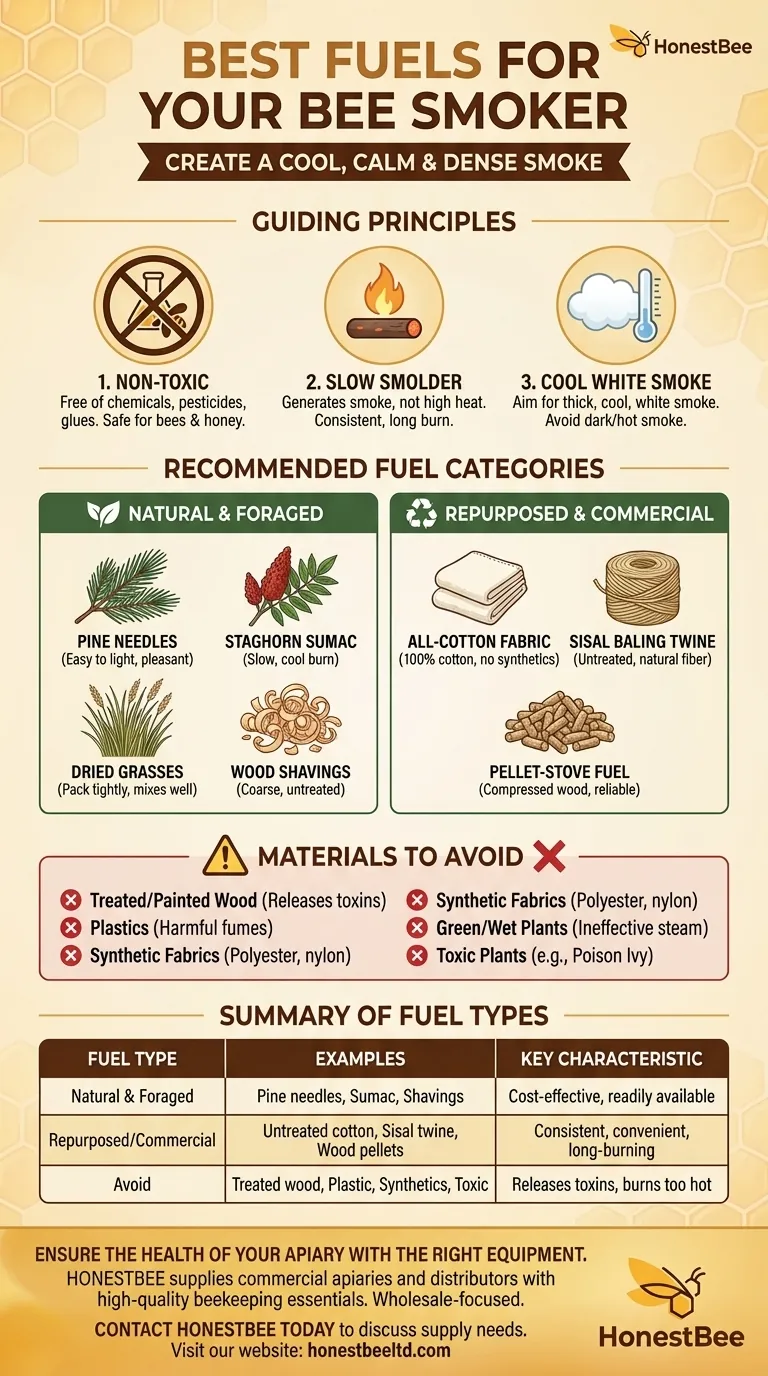
Related Products
- 54-Piece Smoker Fuel Pellets for Beekeeping Beehive Smoker Fuel
- Economy Galvanized Beekeeping Honey Bee Smoker for Wholesale
- Premium Traditional Copper Bee Smoker with Bellows
- Professional Bee Smoker with Elongated Spout and Durable Bellows for Beekeeping
- Stainless Steel Honey Bee Smoker Hive and Honeycomb Smoker for Beekeeping
People Also Ask
- What can I use for bee smoker fuel? Choose Safe, Natural Materials for a Calm Hive
- What is the importance of fuel in a bee smoker? Ensure Cool, Calming Smoke for Your Hive
- What fuels are recommended for beehive smokers? Master the Art of Calm, Controlled Inspections
- What is the best bee hive smoker fuel? Choose Natural, Slow-Burning Fuel for Calm Bees
- How should you start the fire in a bee smoker? A Step-by-Step Guide for a Calm Hive









